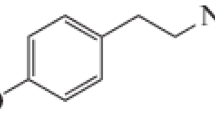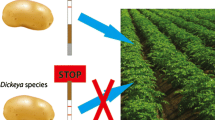Abstract
Alkaline phosphatase (ALP) was used as an amplification tool in lateral flow immunoassay (LFIA). Potato virus Х (PVX) was selected as a target analyte because of its high economic importance. Two conjugates of gold nanoparticles were applied, one with mouse monoclonal antibody against PVX and one with ALP-labeled antibody against mouse IgG. They were immobilized to two fiberglass membranes on the test strip for use in LFIA. After exposure to the sample, a substrate for ALP (5-bromo-4-chloro-3-indolyl phosphate/nitro blue tetrazolium) was dropped on the test strip. The insoluble dark-violet diformazan produced by ALP precipitated on the membrane and significantly increased the color intensity of the control and test zones. The limit of detection (0.3 ng mL−1) was 27 times lower than that of conventional LFIA for both buffer and potato leaf extracts. The ALP-enhanced LFIA does not require additional preparation procedures or washing steps and may be used by nontrained persons in resource-limited conditions. The new method of enhancement is highly promising and may lead to application for routine LFIA in different areas.

Two gold nanoparticles (GNP) conjugates were used – the first with monoclonal antibodies (mAb) (GNP–mAb); the second – alkaline phosphatase-labeled antibody against mAb (GNP–anti-mAb–ALP). The immuno complexes are captured by the polyclonal antibodies (pAb) in the test zone. Addition of the substrate solution (BCIP/NBT) results in the accumulation of the insoluble colored product and in a significance increase in color intensity.





Similar content being viewed by others
References
Shan S, Lai W, Xiong Y et al (2015) Novel strategies to enhance lateral flow immunoassay sensitivity for detecting foodborne pathogens. J Agric Food Chem 63:745–753. https://doi.org/10.1021/jf5046415
Huang X, Aguilar ZP, Xu H et al (2016) Membrane-based lateral flow immunochromatographic strip with nanoparticles as reporters for detection: a review. Biosens Bioelectron 75:166–180. https://doi.org/10.1016/j.bios.2015.08.032
Goryacheva IY, Lenain P, De Saeger S (2013) Nanosized labels for rapid immunotests. TrAC Trends Anal Chem 46:30–43. https://doi.org/10.1016/j.trac.2013.01.013
Mak WC, Beni V, Turner APF (2016) Lateral-flow technology: from visual to instrumental. TrAC Trends Anal Chem 79:297–305. https://doi.org/10.1016/j.trac.2015.10.017
Xu Y, Liu M, Kong N, Liu J (2016) Lab-on-paper micro- and nano-analytical devices: fabrication, modification, detection and emerging applications. Microchim Acta 183:1521–1542. https://doi.org/10.1007/s00604-016-1841-4
Zarei M (2017) Portable biosensing devices for point-of-care diagnostics: recent developments and applications. TrAC Trends Anal Chem 91:26–41. https://doi.org/10.1016/j.trac.2017.04.001
Wild D (2013) The immunoassay handbook. Elsevier, Oxford
Cho JH, Paek EH, Cho IIH, Paek SH (2005) An enzyme immunoanalytical system based on sequential cross-flow chromatography. Anal Chem 77:4091–4097. https://doi.org/10.1021/ac048270d
He Y, Zhang S, Zhang X et al (2011) Ultrasensitive nucleic acid biosensor based on enzyme–gold nanoparticle dual label and lateral flow strip biosensor. Biosens Bioelectron 26:2018–2024. https://doi.org/10.1016/j.bios.2010.08.079
Ren W, Cho I-H, Zhou Z, Irudayaraj J (2016) Ultrasensitive detection of microbial cells using magnetic focus enhanced lateral flow sensors. Chem Commun 52:4930–4933. https://doi.org/10.1039/C5CC10240E
Cho I-H, Bhunia A, Irudayaraj J (2015) Rapid pathogen detection by lateral-flow immunochromatographic assay with gold nanoparticle-assisted enzyme signal amplification. Int J Food Microbiol 206:60–66. https://doi.org/10.1016/j.ijfoodmicro.2015.04.032
Samsonova JV, Safronova VA, Osipov AP (2015) Pretreatment-free lateral flow enzyme immunoassay for progesterone detection in whole cows’ milk. Talanta 132:685–689. https://doi.org/10.1016/j.talanta.2014.10.043
Gao X, L-P X, Wu T et al (2016) An enzyme-amplified lateral flow strip biosensor for visual detection of MicroRNA-224. Talanta 146:648–654. https://doi.org/10.1016/j.talanta.2015.06.060
Parolo C, de la Escosura-Muñiz A, Merkoçi A (2013) Enhanced lateral flow immunoassay using gold nanoparticles loaded with enzymes. Biosens Bioelectron 40:412–416. https://doi.org/10.1016/j.bios.2012.06.049
Safronova VA, Samsonova JV, Grigorenko VG, Osipov AP (2012) Lateral flow immunoassay for progesterone detection. Mosc Univ Chem Bull 67:241–248. https://doi.org/10.3103/S0027131412050045
Cho I-H, Irudayaraj J (2013) Lateral-flow enzyme immunoconcentration for rapid detection of listeria monocytogenes. Anal Bioanal Chem 405:3313–3319. https://doi.org/10.1007/s00216-013-6742-3
Bania I, Mahanta R (2012) Evaluation of peroxidases from various plant sources. Int J Sci Res Publ 2:1–5
Lathwal S, Sikes HD (2016) Assessment of colorimetric amplification methods in a paper-based immunoassay for diagnosis of malaria. Lab Chip 16:1374–1382. https://doi.org/10.1039/C6LC00058D
Santivañez SJ, Rodriguez ML, Rodriguez S et al (2015) Evaluation of a new immunochromatographic test using recombinant antigen B8/1 for diagnosis of cystic echinococcosis. J Clin Microbiol 53:3859–3863. https://doi.org/10.1128/JCM.02157-15
Endo F, Tabata T, Sadato D et al (2017) Development of a simple and quick immunochromatography method for detection of anti-HPV-16/−18 antibodies. PLoS One. https://doi.org/10.1371/journal.pone.0171314
Ono T, Kawamura M, Arao S, Nariuchi H (2003) A highly sensitive quantitative immunochromatography assay for antigen-specific IgE. J Immunol Methods 272:211–218. https://doi.org/10.1016/S0022-1759(02)00504-5
Strange RN, Scott PR (2005) Plant disease: a threat to global food security. Annu Rev Phytopathol 43:83–116. https://doi.org/10.1146/annurev.phyto.43.113004.133839
Goodman RM (1975) Reconstitution of potato virus X in vitro. I. Properties of the dissociated protein structural subunits. Virology 68:287–298
Safenkova IV, Zherdev AV, Dzantiev BB (2010) Correlation between the composition of multivalent antibody conjugates with colloidal gold nanoparticles and their affinity. J Immunol Methods 357:17–25. https://doi.org/10.1016/j.jim.2010.03.010
Frens G (1973) Controlled nucleation for the regulation of the particle size in monodisperse gold suspensions. Nat Phys Sci 241:20–22. https://doi.org/10.1038/physci241020a0
Hermanson GT (2008) Biotinylation reagents. In: Hermanson GT Bioconjugate Techniques, 2nd edn. Elsevier, New York, pp 506–545
Byzova NA, Safenkova IV, Chirkov SN et al (2009) Development of immunochromatographic test systems for express detection of plant viruses. Appl Biochem Microbiol 45:204–209. https://doi.org/10.1134/S000368380902015X
Phillips TM (2005) Affinity chromatography in antibody and antigen purification. In: Hage DS, Cazes J (eds.) Handbook of affinity chromatography, 2nd edn. CRC press, Boca Raton, pp 367–397
Safenkova I, Zherdev A, Dzantiev B (2012) Factors influencing the detection limit of the lateral-flow sandwich immunoassay: a case study with potato virus X. Anal Bioanal Chem 403:1595–1605. https://doi.org/10.1007/s00216-012-5985-8
Chen M, Yu Z, Liu D, Peng T, Liu K, Wang S, Xiong Y, Wei H, Xu H, Lai W (2015) Dual gold nanoparticle lateflow immunoassay for sensitive detection of Escherichia Coli O157:H7. Anal Chim Acta 876:71–76. https://doi.org/10.1016/j.aca.2015.03.023
Rodríguez MO, Covián LB, García AC, Blanco-López MC (2016) Silver and gold enhancement methods for lateral flow immunoassays. Talanta 148:272–278. https://doi.org/10.1016/j.talanta.2015.10.068
Taranova NA, Urusov AE, Sadykhov EG, Zherdev AV, Dzantiev BB (2017) Bifunctional gold nanoparticles as an agglomeration-enhancing tool for highly sensitive lateral flow tests: a case study with procalcitonin. Microchim Acta 184:4189–4195. https://doi.org/10.1007/s00604-017-2355-
Rettcher S, Jungk F, Kühn C et al (2015) Simple and portable magnetic immunoassay for rapid detection and sensitive quantification of plant viruses. Appl Environ Microbiol 81:3039–3048. https://doi.org/10.1128/AEM.03667-14
Drygin YF, Blintsov AN, Grigorenko VG et al (2012) Highly sensitive field test lateral flow immunodiagnostics of PVX infection. Appl Microbiol Biotechnol 93:179–189. https://doi.org/10.1007/s00253-011-3522-x
Banttari EE (1991) Rapid magnetic microsphere enzyme immunoassay for potato virus x and potato leafroll virus. Phytopathology 81:1039–1042. https://doi.org/10.1094/Phyto-81-1039
Caglayan MG, Kasap E, Cetin D et al (2017) Fabrication of SERS active gold nanorods using benzalkonium chloride, and their application to an immunoassay for potato virus X. Microchim Acta 184:1059–1067. https://doi.org/10.1007/s00604-017-2102-x
Safenkova IV, Pankratova GK, Zaitsev IA et al (2016) Multiarray on a test strip (MATS): rapid multiplex immunodetection of priority potato pathogens. Anal Bioanal Chem 408:6009–6017. https://doi.org/10.1007/s00216-016-9463-6
Panferov VG, Safenkova IV, Zherdev AV, Dzantiev BB (2017) Setting up the cut-off level of a sensitive barcode lateral flow assay with magnetic nanoparticles. Talanta 164:69–76. https://doi.org/10.1016/j.talanta.2016.11.025
Weilbach A, Sander E (2000) Quantitative detection of potato viruses X and Y (PVX, PVY) with antibodies raised in chicken egg yolk (IgY) by ELISA variants. J Plant Dis Prot 107:318–328
Acknowledgments
The study was financially supported by the Russian Science Foundation (grant 16-16-04108).
Author information
Authors and Affiliations
Corresponding author
Ethics declarations
Conflict of interest
The author(s) declare that they have no competing interests.
Electronic supplementary material
ESM 1
(DOCX 1020 kb)
Rights and permissions
About this article
Cite this article
Panferov, V.G., Safenkova, I.V., Varitsev, Y.A. et al. Enhancement of lateral flow immunoassay by alkaline phosphatase: a simple and highly sensitive test for potato virus X. Microchim Acta 185, 25 (2018). https://doi.org/10.1007/s00604-017-2595-3
Received:
Accepted:
Published:
DOI: https://doi.org/10.1007/s00604-017-2595-3




